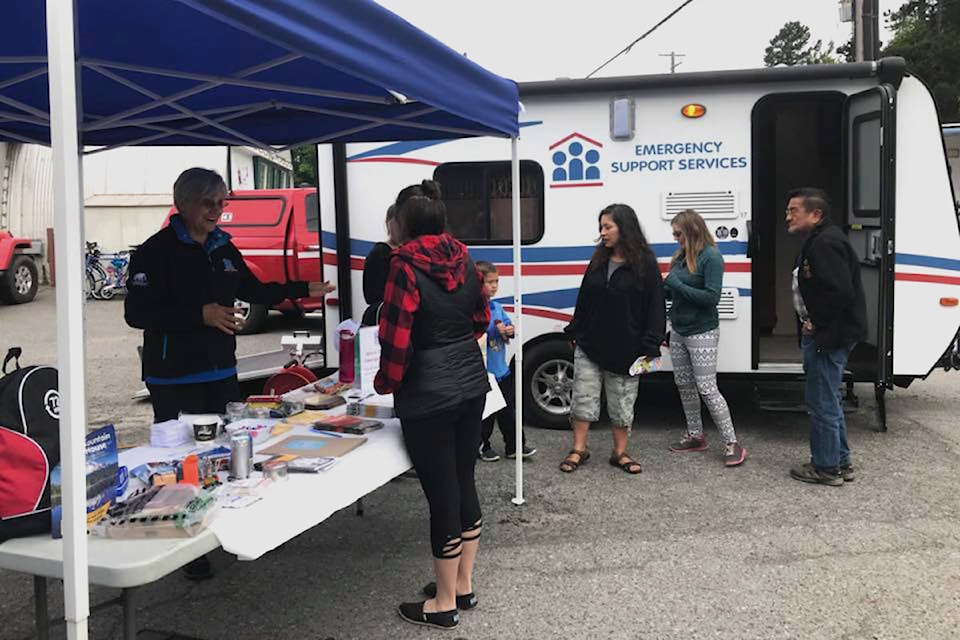Last summer’s wildfires in the Telegraph Creek area have triggered the Regional District of Kitimat-Stikine (RDKS) and Emergency Support Services (ESS) to re-examine mass evacuation plans and strategies. It’s typically expected the volunteer-based service provides response assistance for 72 hours following an emergency.
However, ESS ended up providing care throughout the district for five months last year, and the coordinator is concerned this may become the norm.
“It was a challenge because we never experienced anything to this magnitude in our region before… the last five months of 2018 was just insane for us,” says Naomi Gourlay, ESS program coordinator. “We’re all trying to regroup and come up with plans so that we can prepare for the flood and wildfire season that will be upon us before we know it.”
The wildfires of 2018 have been noted as the worst fire season on B.C. record, burning close to 13,000 sq. km of forest. More than 1,200 sq. km burned in the Telegraph Creek area. “The Tahltan Nation itself incurred the worst structural damage caused by wildfires of any First Nations community in recorded Canadian history,” said Indigenous Services Minister Jane Philpott, during a November visit to the area.
It wasn’t until Dec. 21 when evacuees finally began returning home that ESS was able to pull back. Gourlay says it’s been tough to plan ahead after spending so much time in response. Moving forward now, they would like to facilitate more regional and provincial discussion and collaborations.
Under the province’s Emergency Program Act, the local and regional authority “may implement all procedures that it considers necessary to prevent, respond or alleviate the effects of an emergency or disaster”. This includes utilizing its emergency plan of which ESS is a key component.
READ MORE: Telegraph Creek evacuees may be home by Christmas
Gourlay says that they had about 40 volunteers working around the clock in reception centres established in Terrace, Dease Lake and Iskut. They logged about 1,700 responder hours from the beginning of August. EMBC provided support by deploying mobile support teams from other parts of B.C.
The current volunteer-based ESS model is ready to handle level one and two emergencies — but the mass evacuations that took place across the Northwest were considered a level three response.
ESS with the RDKS is now evaluating what needs to be done to ensure they’re prepared for the next call, including developing strategies and examining ongoing capacities to deal with future evacuations.
Emotional support has been in place and will continue for both evacuees and ESS volunteers who have been deeply affected by the accounts of grief and loss.
“You can imagine that you’re dealing with people who have gone through a lot of trauma and how that can impact you as well, we have to think of that,” says Gourlay.
READ MORE: B.C. works to prepare for future wildfire, flood seasons
ESS’ operations are managed through the RDKS, with support from the City of Terrace.
Emergency Management BC (EMBC) covers the referral costs provided by ESS to evacuees. Over $1.7 million in referral was given out in terms of food, clothing and accommodation.
Throughout the year, ESS must establish relationships in the region with organizations, plus restaurant, store and hotel owners, to have signed agreements for their services and participation during emergencies. Local businesses are then reimbursed by EMBC.
At one point during last summer though, hotels in Terrace and Dease Lake were at capacity.
Gourlay says they have a stockpile of 250 cots and 500 blankets in storage in case they need to turn to group lodging as an option. This would mean setting up rows of beds in a mass space such as churches, schools and sports facilities. This has never been done before, but it’s likely to be used if regional disasters continue to grow in scale.
“We want to avoid opening up group lodging, as it would be a lot of work and resources. And with volunteers, it would be difficult to ask them to step up to that,” says Gourlay. “It’s going to require more creativity, working together hand-in-hand with the province.”
She says with the RDKS being such a large district in B.C., they face many unique challenges than their counterparts further south, with needs that must be addressed in upcoming discussions.
As part of their recovery process, the Tahltan/RDKS recovery manager has been contacting residents affected by the regional disaster to follow up on how they’re doing after the evacuations.
The Red Cross visited the area to conduct a second round of interviews in Terrace on Jan. 14 and 15, then Dease Lake and Telegraph Creek the week of Jan. 21.
“We also have to be mindful that there were other people involved beyond the community members of Telegraph Creek. The surrounding areas were also impacted and there’s a lot of residents there as well,” says Gourlay.
“Knowing one another really helps a lot in these small towns… We need to make it a priority to have these discussions in advance so we can consolidate all of our plans with a better understanding of what we need to do.”
natalia@terracestandard.com
Like us on Facebook and follow us on Twitter

